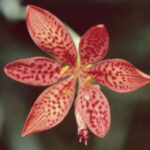Flag Irises are popular and widely grown for their colorful flowers and handsome foliage. They make dramatic accent plants for the flower border.
Flag Irises are also know as German Irises, and they are easy to grow from rhizomes, developing into large, permanent clumps. They have handsome grey-green sword-like leaves and flowers that resemble orchids, in a wide range of colors including gold, yellow, lavender, mauve, purple, brown and white. Some varieties combine more than one flower color, and can be used to create a wonderful effect in the garden.
Varieties worth introducing into a colorful mixed border include: Iris germanica, or common Flag, which gas bearded flowers in the yellow, blue-purple and blue-violet color range; Iris missouriensis, or Missouri Flag, which is a beardless ‘Pacific Coast’ hybrid with blue, lilac, white or lavender flowers; and Iris ensata, or Japanese Flag, which comes in hundreds of varieties, including some with double flowers, in the purple, pink, lavender and white color range.
Flag Irises are bold accent plants, with their striking foliage and colorful flowerheads. They can be planted by themselves in large, showy clumps, or mixed with other flowering bulbs or perennials in a mixed flower border.
Make a strong statement beside a garden pond or waterfall by clumping Flag Irises where their reflection will be captured in the water.
Create a cut-flower garden with other easy-to-grow varieties that will be ideal for indoor decoration. If planting in rows, make them 1 meter apart for easy cutting.
Use Flag Irises in a large rockery, positioned towards the back of the garden in groups of five or more. When planting different colored Flag Irises, look for complementary contrasts such as: yellow and blue; blue and white; brown and yellow.
The most dramatic effect is a mass planting, with 15 or more rhizomes grouped together. Plant taller varieties towards the back or side of the garden bed, and then combine with perennials, such as Peonies, Geraniums (the old-fashioned varieties commonly known as Cranesbill) and Granny’s Bonnets (Aquilegia species) for a pleasing effect.
Combine Iris with ground-covering plants such as Lamb’s Ears, which have silvery-grey foliage, and Bugle Flower, which has deep bronze foliage that will provide an eye-pleasing contrast.
Planting Iris
1. Dig up the soil in the planting area to a depth of 15cm. Add a spadefuls of compost and a light sprinkling of blood and bone to the area to be planted.
2. Plant the rhizomes, with the leaves facing upwards and roots facing downwards. Do not plant them deeper than 2 cm, or they may rot.
3. Replace the soil and compost mixture, making sure that one third of the rhizome is above ground level. Allow 30cm between each.
4. Water in thoroughly, but do not mulch until the plants are well established, or the mulch layer may smother the rhizomes.
5. Feed the plants with a handful of blood and bone, mixed with a teaspoon of potash. Feed again in early spring with the same mix.
Every three years each clump or Irises can be lifted in autumn, and divided. Use a sharp knife to cut the rhizomes into two or three pieces.
When purchasing Iris rhizomes, look for firm and plump ones. Healthy plants should have stringy roots all about the same length. Do not buy rhizomes that are soft or spongy to the touch or those with any brown marks, mildew or blemishes that indicate weakness or disease.
Full sun is essential, for the Iris to thrive, except in hot climates when some protection from the midday sun may be useful. Good drainage is also important, but the soil should be capable of holding moisture. Extra compost added at planting time will improve the texture.
Avoid letting fertilizer come into direct contact with the rhizomes, as this may have a burning effect. When flowering has finished, cut back the flowering stem but allow the foliage to remain, as it assists in building up food for the next flowering season.
Flag Irises can be affected by a fungus which appears as purple brown spots on the foliage. It is caused by poor drainage. Remove affected foliage and apply a copper spray. Transplant the Iris to a well-drained bed to avoid too much moisture around the roots.
Seasonal tips
Autumn: Buying and planting
Prepare the garden beds and look for suitable rhizomes in your nursery. They can also be bought by mail order from a specialist Iris grower.
Winter: General maintenance
Never over water rhizomes and control the weeds.
Spring: Feeding and watering
Water routinely and feed with blood and bone mixed with sulphate or potash.
Summer: Tidying and mulching
Cut back spent flower stems at the base and trim off any dead or diseased foliage. Mulch taking care not to cover the rhizomes.





